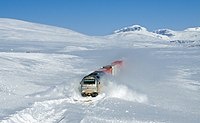
Estimation of the Effects of Neonicotinoid Insecticides on Wild Raccoon, Procyon lotor, in Hokkaido, Japan: Urinary Concentrations and Hepatic Metabolic Capability of Neonicotinoids
Sign Up to like & getrecommendations! Published in 2022 at "Environmental Toxicology and Chemistry"
DOI: 10.1002/etc.5349
Abstract: Toxicological effects of neonicotinoid insecticides (NNIs) have been reported for mammals, such as humans, rats, and mice. However, there are limited reports on their toxic effects on wild mammals. To predict NNI‐induced toxic effects on… read more here.
Keywords: toxicology; urinary concentrations; effects neonicotinoid; chemistry ... See more keywords

The effect of melting treatments on the assessment of biomass and nutrients in sea ice (Saroma-ko lagoon, Hokkaido, Japan)
Sign Up to like & getrecommendations! Published in 2018 at "Polar Biology"
DOI: 10.1007/s00300-018-2426-y
Abstract: Melting of sea-ice samples is an inevitable step in obtaining reliable and representative measurements for biogeochemical parameters such as inorganic nutrients and particulate matter. The impact of the sea-ice melting procedure has been previously evaluated… read more here.
Keywords: sea ice; biomass; hokkaido japan; saroma lagoon ... See more keywords

Seasonal variation in spore levels of Bacillus cereus and its psychrotrophic strains in raw milk in Hokkaido, Japan, and evaluation of strain diversity
Sign Up to like & getrecommendations! Published in 2019 at "International Dairy Journal"
DOI: 10.1016/j.idairyj.2019.06.011
Abstract: Abstract Bacillus cereus is a spore-forming bacterium that adversely affects the quality of high-temperature short-time (HTST) pasteurised milk. Using a membrane filtration method, we investigated B. cereus spore levels in raw milk from dairy plants in… read more here.
Keywords: hokkaido japan; raw milk; milk; spore levels ... See more keywords

Potential negative effects and heterogeneous distribution of a parasitic copepod Salmincola edwardsii (Copepoda: Lernaeopodidae) on Southern Asian Dolly Varden Salvelinus curilus in Hokkaido, Japan.
Sign Up to like & getrecommendations! Published in 2021 at "Parasitology international"
DOI: 10.1016/j.parint.2021.102529
Abstract: The genus Salmincola is an ectoparasitic copepod group commonly infesting the branchial and buccal cavities of salmonids. While negative impacts on hatchery fishes have been reported, their impacts on wild fish populations and distribution patterns… read more here.
Keywords: southern asian; asian dolly; copepod; salmincola ... See more keywords

Response of snowpack to +2°C global warming in Hokkaido, Japan
Sign Up to like & getrecommendations! Published in 2019 at "Journal of Glaciology"
DOI: 10.1017/jog.2019.85
Abstract: Abstract The response of snowpack to a +2°C global warming relative to the present climate was estimated in Hokkaido, Japan, using a physical snowpack model driven by dynamically downscaled (DDS) data, after model evaluation. The… read more here.
Keywords: snowpack; response snowpack; hokkaido; hokkaido japan ... See more keywords

A novel nairovirus associated with acute febrile illness in Hokkaido, Japan
Sign Up to like & getrecommendations! Published in 2021 at "Nature Communications"
DOI: 10.1038/s41467-021-25857-0
Abstract: The increasing burden of tick-borne orthonairovirus infections, such as Crimean-Congo hemorrhagic fever, is becoming a global concern for public health. In the present study, we identify a novel orthonairovirus, designated Yezo virus (YEZV), from two… read more here.
Keywords: febrile illness; hokkaido japan; acute febrile; illness ... See more keywords

A new species of Paramoera (Crustacea: Amphipoda: Pontogeneiidae) from an estuary habitat in Hokkaido, Japan
Sign Up to like & getrecommendations! Published in 2020 at "Journal of Natural History"
DOI: 10.1080/00222933.2020.1785031
Abstract: ABSTRACT A new species of the pontogeneiid amphipod Paramoera shakotanensis from the mouth of Horonaifu River, Hokkaido, Japan, is described. Paramoera shakotanensis sp. nov. can clearly be distinguished from its congeners by a combination of… read more here.
Keywords: new species; crustacea amphipoda; species paramoera; hokkaido japan ... See more keywords

Region-specific linear site amplification model for peaty organic soil sites in Hokkaido, Japan
Sign Up to like & getrecommendations! Published in 2022 at "Earthquake Spectra"
DOI: 10.1177/87552930221082965
Abstract: We develop a site amplification model for a regional geologic condition that includes surficial deposits of peaty organic soils in Hokkaido, Japan. We use ground motion data from national Japanese networks along with local data… read more here.
Keywords: site amplification; peaty organic; hokkaido japan; model ... See more keywords

Characterization of Penicillium Species Isolated from Dioscorea polystachya in Hokkaido, Japan
Sign Up to like & getrecommendations! Published in 2022 at "Mycoscience"
DOI: 10.47371/mycosci.2022.11.002
Abstract: Chinese yam (Dioscorea polystachya) has been cultivated as a food crop in Japan. The blue mold disease of Chinese yam during the storage and treatment of forced sprouting is one of the hindrances in attaining… read more here.
Keywords: dioscorea polystachya; penicillium; characterization penicillium; blue mold ... See more keywords